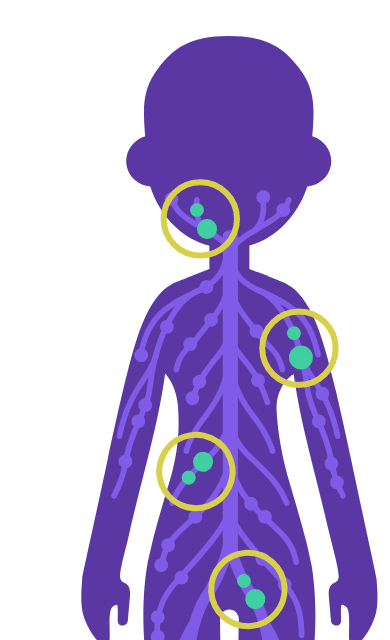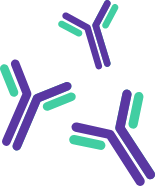iMCD: A mysterious condition that mimics many other diseases
iMCD: A rare lymphoproliferative disorder1,3
About 1000 to 1100 new patients are diagnosed with iMCD in the United States every year3
Malignancies arising within the first year after diagnosis (N=119)6
Understanding Castleman disease and its subtypes
Castleman disease (CD) describes a group of distinct, nonmalignant lymphoproliferative disorders with a shared histopathology.2,4
iMCD: Likely the most prevalent subtype of Castleman disease
There are 3 known subtypes of MCD. Their classifications are based on the number of
regions of enlarged lymph nodes and the presence or absence of human herpesvirus-8 (HHV-8) or
the POEMS syndrome
criteria.1,2,4,8,9
iMCD
A patient diagnosed with human immunodeficiency virus (HIV)–negative and HHV-8–negative MCD is
classified as an iMCD patient.2
POEMS-associated MCD
Polyneuropathy, organomegaly, endocrinopathy, monoclonal gammopathy, and skin changes
(POEMS)–associated MCD is defined by the presence of either bone lesions or a λ-restricted
plasma cell disorder.1
HHV-8–positive MCD
This subtype of iMCD can cause Kaposi’s sarcoma—a rare cancer in which lesions grow on the skin,
mouth, nose, throat, and other parts of the body.1,4,8,9
iMCD is a rare disease that can be difficult to diagnose, as its characteristics are similar
to cancers such as non-Hodgkin lymphoma, autoimmune disorders such as rheumatoid arthritis, and
infectious disorders such as HIV.1

iMCD represents ~60% of all CD cases. Learn more about the prevalence of the subtypes of CD.3
Corey Casper, MD, MPHThe diagnosis of iMCD could be extremely challenging, and one initially has to rule out some of these other mimicking conditions.

Common symptoms of iMCD
The presentation of iMCD can vary from patient to patient. It can range from mild constitutional symptoms such as fever and night sweats to a life-threatening cytokine storm, which can lead to organ failure.3,5,7
Here are some of the most commonly observed symptoms:
In patients with iMCD, interleukin-6 (IL-6) levels may be elevated during flare-ups and correlate with the intensity of their symptoms2,7,10
Sign up for more on iMCD
"*" indicates required fields
By checking the adjacent box, you agree to allow EUSA Pharma to collect the information provided and to be contacted by EUSA Pharma in the future regarding its IL-6 neutralizing products and related disease education.
By submitting this form, you agree to allow EUSA Pharma to collect the information provided and to be contacted directly by a EUSA Pharma sales representative. Your information will not be used for any other purpose than for a representative to respond to your information request, or for us to send you other EUSA Pharma updates if you have registered to receive them.
EUSA Pharma will not sell, rent, or otherwise distribute your name and any personally identifiable information outside of EUSA Pharma. EUSA Pharma will only use your information in accordance with its Privacy Policy.
-
Fajgenbaum DC, Uldrick TS, Bagg A, et al. International, evidence-based consensus diagnostic criteria for HHV-8–negative/idiopathic multicentric Castleman disease. Blood. 2017;129(12):1646-1657.
-
Fajgenbaum DC. Novel insights and therapeutic approaches in idiopathic multicentric Castleman disease. Blood. 2018;132(22):2323-2330.
-
Mukherjee S, Martin R, Sande B, Paige JS, Fajgenbaum DC. Epidemiology and treatment patterns of idiopathic multicentric Castleman disease in the era of IL-6-directed therapy. Blood Adv. 2022;6(2):359-367.
-
About Castleman disease. American Cancer Society. https://www.cancer.org/content/dam/CRC/PDF/Public/8594.00.pdf. Revised February 1, 2018. Accessed May 11, 2022.
-
Sitenga J, Aird G, Ahmed A, Silberstein PT. Impact of siltuximab on patient-related outcomes in multicentric Castleman’s disease. Patient Relat Outcome Meas. 2018;9:35-41.
-
Mukherjee S, Martin R, Sande B, et al. A longitudinal population level analysis of healthcare resource utilization, comorbidity, and survival in idiopathic multicentric Castleman disease patients. Presented at: 62nd American Society of Hematology (ASH) Annual Meeting and Exposition; December 5-8, 2020; virtual meeting.
-
Liu AY, Nabel CS, Finkelman BS, et al. Idiopathic multicentric Castleman’s disease: a systematic literature review. Lancet Haematol. 2016:3(4):e163-e175.
-
Dictionary of Cancer Terms: kaposi sarcoma. National Cancer Institute. https://www.cancer.gov/publications/dictionaries/cancer-terms/def/kaposi-sarcoma. Accessed June 9, 2022.
-
Dictionary of Cancer Terms: kaposi sarcoma-associated herpesvirus. National Cancer Institute. https://www.cancer.gov/publications/dictionaries/cancer-terms/def/kaposi-sarcoma-associated-herpesvirus. Accessed June 9, 2022.
-
England JT, Abdulla A, Biggs CM, et al. Weathering the COVID-19 storm: lessons from hematologic cytokine syndromes. Blood Rev. 2021;45:100707.
-
van Rhee F, Voorhees P, Dispenzieri A, et al. International, evidence-based consensus treatment guidelines for idiopathic multicentric Castleman disease. Blood. 2018;132(20):2115-2124.
-
Garbers C, Heink S, Korn T, Rose-John S. Interleukin-6: designing specific therapeutics for a complex cytokine. Nat Rev Drug Discov. 2018;17(6):395-412.
-
Choy EH, De Benedetti F, Takeuchi T, Hashizume M, John MR, Kishimoto T. Translating IL-6 biology into effective treatments. Nat Rev Rheumatol. 2020;16(6):335-345.
-
Dictionary of Cancer Terms: flu-like symptoms. National Cancer Institute. https://www.cancer.gov/publications/dictionaries/cancer-terms/def/flu-like-symptoms. Accessed June 9, 2022.
Your iMCD Diary
Save and use this Patient Diary online with your Google account by selecting “Google Sheet” and then “Use Template,” or download to your computer by selecting “Excel File.”
No data is stored by or transferred to this KnowiMCD.com website. This site contains links to other websites, and these links will direct users to third-party sites.
Loading...
Please wait a moment.
Are you located in the United States?
If so, you will be directed to the website that contains information intended for a US audience.
Viral hemophagocytic lymphohistiocytosis.
A doctor who specializes in the branch of medicine that deals with rheumatic conditions.
Polyneuropathy, organomegaly, endocrinopathy, monoclonal gammopathy, and skin changes.
Positron emission tomography (PET) is a method of producing a 3-dimensional image of the internal
structures of body tissues after administering a natural biochemical substance like glucose or fatty
acids. These images are generated with the help of a computer.
A doctor who evaluates the changes caused by disease in tissues and body fluids and helps reach a
diagnosis.
A doctor who specializes in the diagnosis and treatment of kidney abnormalities.
Macrophage activation syndrome.
Malignancy-associated hemophagocytic lymphohistiocytosis.
A disease in which cells of the lymph system grow excessively
Lymph nodes make immune cells that help the body fight infection.
A key signaling molecule that helps to regulate the body’s immune system.
Infectious disease medicine is the subspecialty of internal medicine that focuses on diagnosing and
managing infections.
A rare condition that affects multiple groups of lymph nodes throughout the body. Patients with iMCD
are HIV negative and HHV-8 negative.
The underlying cause or origin of a disease is unknown.
Hemophagocytic lymphohistiocytosis.
Human immunodeficiency virus.
Human herpesvirus-8.
A doctor who specializes in the branch of medical science that deals with cancers of the blood and
blood-forming tissues.
Powerful molecules that are normally secreted by the cells of the immune system in response to
infectious or noninfectious agents.
An overreaction of the body’s immune system in which too many cytokines are released into the
bloodstream very quickly, with potentially severe or life-threatening effects.
Computed tomography (CT) is a method of producing an image of the internal structures by passing an
x‑ray through the body.
The removal and examination of tissue, cells, or fluids from the body.
A condition in which the body’s immune system accidentally attacks itself.
Autoimmune lymphoproliferative syndrome.
You are now leaving KnowiMCD.com.
Please click “OK” to continue or “CANCEL” to return to KnowiMCD.com














